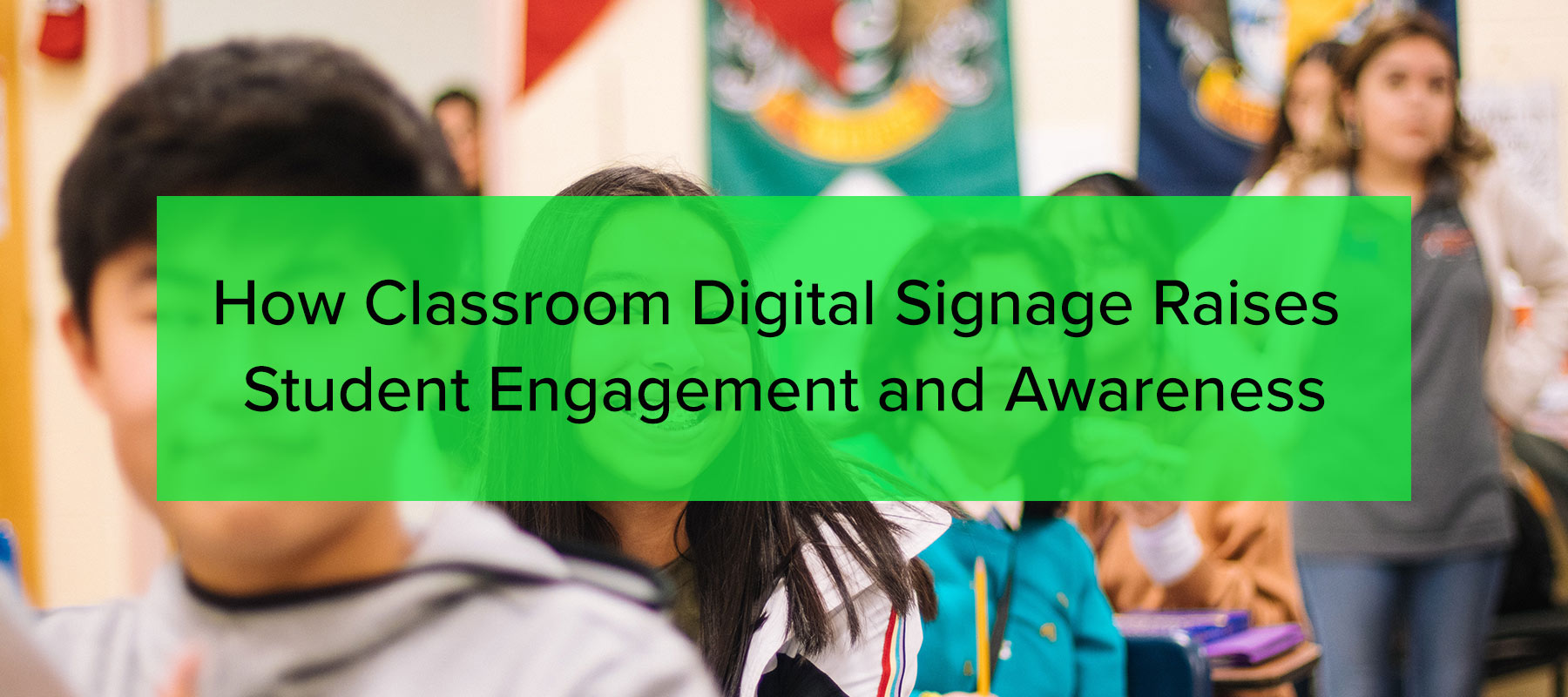
Every teacher wants students to be engaged with what they’re teaching. More engaged students do better in class, and in life. Beyond the classroom, engagement with the school community is a vital component of student well-being and personal growth. How can digital signage help?
Schools can use digital signage to guide student behavior, and to help students stay on track by providing the information they need to make the right decision academically. Signage can create significant changes in the atmosphere and culture of a school, guide individual students back onto task in the classroom, and help lost newcomers find the cafeteria. With centralized digital signage tools, a small number of displays can do all this, and more.
Let’s start with the classroom.
Driving Student Engagement and Awareness in Class
If there’s one place student awareness and attention is at a premium, it’s the classroom. Teachers do what they can to make lessons engaging, but with time at a premium and every minute accounted for in lesson plans, students are still inclined to tune out — especially if they don’t feel supported. Digital signage offers powerful tools to change that.
Presentations
One of the simplest ways to leverage free digital signage in classrooms is to use the same technology for presentations. Any digital signage tool designed with education in mind will work with the presentation tools educators rely on. Rise Vision has templates that allow you to simply display Google Slides or Powerpoint presentations directly inside your Rise Vision installation:

Get started with this Google Slides digital signage template here.
This approach has advantages over casting a presentation from a laptop to a wall-mounted display. It lets teachers build the presentation into a class signage plan that also includes learning support cues and other signage effects. It also usually offers better quality and reliability.
Some schools use specialized presentation tools that offer more education-friendly options than Powerpoint and Slides. Rise Vision works great with these too, thanks to a fully-blank template that lets you switch easily between crystal-clear presentations and classroom-oriented digital signage.
Digital signage tools let you construct complex, multimedia presentations that include videos, commentary and analysis, animated diagrams, audio, and more. Teachers remain in control, navigation is easy, and constructing and displaying content is simple. It’s easier to achieve this in template-rich digital signage systems than in many legacy office-oriented productivity tools. (With Rise Vision’s Unlimited License, schools can operate an unlimited number of screens, schedules, slides and content, so every lesson can be augmented without budgetary constraints.)
Nudging
Nudging and priming are methods of changing behavior that use modeling, encouragement, incentivization, and reminding people of values rather than instruction or discipline. Once the idea is understood, they’re low-effort, high-reward actions that can have a significant effect on how people act.
Nudging means stepping in with messaging at the moment when people are making a decision that you’d like them to approach differently. For example, when students begin getting equipment out in science class or picking up chisels in shop, it might seem unlikely that a simple reminder to observe safety rules would produce a major change in behavior.
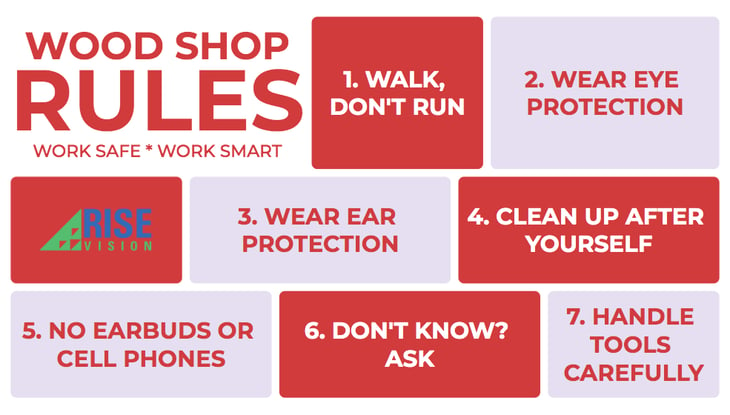
Made in under two minutes from the Classroom Rules template in Rise Vision’s template editor
But we’ve seen that compliance with safety rules can rise 640% with nudging when it’s done right. Digital signage can be changed to show the right messaging for the right audience at the right time, stepping in to help guide their decision-making process; it’s the ideal tool for classroom nudging.
Priming
Priming means changing the way people respond to one stimulus, by exposing them to another stimulus first. For instance, you might prime students to see themselves as good at math before taking a tough test. Each of us tells ourselves several stories about who we are; changing which story we pay attention to can change our decision-making process. Encouraging students to see themselves as people who can learn and improve, rather than as people who just are ‘bad at’ or ‘good at’ things, can help change the way they approach tasks and drive significant changes in outcomes.
For instance, when students are embarking on a task, they might be thinking, ‘this is enjoyable and rewarding, and it ties into my long-term goals.’ Or they might be thinking, ‘this is uninteresting. I am bound to fail at it and anyway I don’t care about this subject.’ Can we change this student’s mind? Yes and no. We can encourage them to choose one of these narratives over the other, and the results of doing that can be startling.
Priming can also be used to improve classroom atmosphere and behavior by encouraging students to interpret ambivalent interpersonal interactions in a positive or neutral rather than in a negative light, allowing minor grievances to be resolved without blossoming into major ones.
Learning Support Cues
The process of working through a classroom task can be modeled as a decision map, in which students reach junctions with many possible directions. For example, when writing a paper, a student might need a citation. That means they need to find the right book, then check the index for the right topic, then read the right text, then cite it correctly.
When people forget how to do tasks that lead to their goals, they’ll often default to another behavior entirely. Typically, they’ll choose one that offers more short-term reward but no longer serves their long-term goals. When you get bored, frustrated, or upset, you often want to deal with the bad feeling first.
Young people are practicing new skills in stressful environments using newly-acquired executive functions. They are particularly susceptible to this effect. This is how kids in class wind up acting out, zoning out, or goofing off when they’re supposed to be working.

Created in under a minute from the Library Reminder template in Rise Vision’s content editor
Digital signage can help reorient students to engage with the task they’re undertaking, helping them to stay on the right ‘road’ on their decision map and arrive at the outcome that aligns with their long-term goals. Digital signage can function as a kind of mental road sign, reminding students of what they need to know to successfully complete tasks. That way, when students get stuck and think, ‘um, what now?’ they look up — and the information they need to get back on track is right there.
Driving Student Engagement and Awareness on Campus
Wayfinding and Scheduling
On any campus, no student is more than 180 days from starting a new schedule. Some students have excellent organizational skills and are never lost. One or two never really grasp things and are just getting the hang of this year’s schedule when the school year ends. But many students are somewhere in the middle.
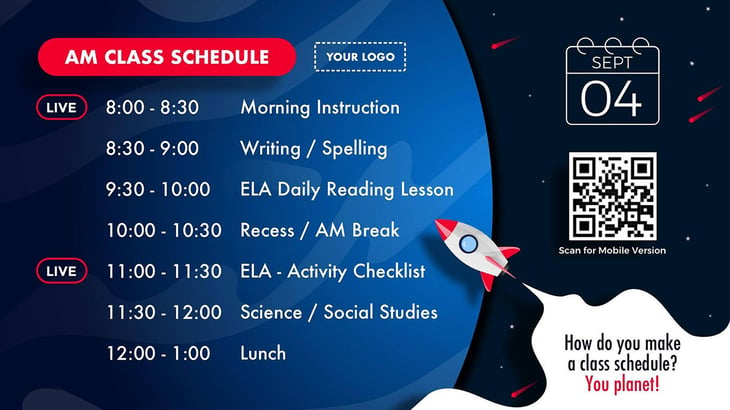
Get started with this digital signage template here.
Wayfinding can be a problem too. Even if a student has been at a school for years, they might start their new grade and learn they have classes in rooms, on floors, or in buildings they’ve never had to visit before. Multicampus schools will see a similar effect magnified.
Digital signage can help these students orient themselves in the school day and the school campus. Students who can find their way around are more focused, less anxious and distracted, and more likely to be at their next class on time.
Events
A school event is about more than the sport, academic subject or cultural occasion that it’s centered around. It’s an opportunity for the school and its community to come together, and to experience and celebrate its shared identity. That process may be hard to quantify and assess directly. But even though we know it’s a ‘black box,’ the outcomes are increasingly well-researched, and the trend is clear.
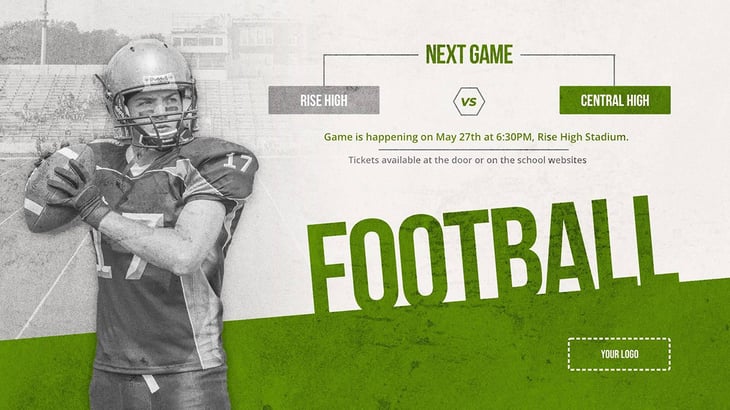
Get started with this football-themed digital signage template here.
Students perform better in schools when their community supports scholastic achievement, and schools as a whole perform better when their community supports them. At the same time, a community with deep-seated problems can begin to turn around if its schools are good, both socially and scholastically.
Within the school community itself, school events offer a way for students to engage with each other and their interests. For example, the school play will clearly be of interest to the theater club. Students with a strong interest in English might look up too. But those who can’t tell West Side Story from The Addams Family might also find their passions catered to — if they’re encouraged to write the code that controls the lighting, wire up the sound system, design the costumes, or bolt, weld, and carpenter the sets together.
None of that can happen if students aren’t aware that events are taking place at all, or if they assume that they aren’t interested and won’t be welcomed. Traditional signage solutions — usually a board with card or paper notices held in with thumbtacks — only add to the problem. Students ignore them unless they’re actively looking for something, so they’re never going to encounter a new idea while they’re just walking the halls. Digital signage can attract students’ attention and convince them that they, too, have a part to play.
Clubs
Many school clubs struggle to attract new membership for the same reason that events struggle to coalesce the school behind them. Students aren’t looking for them, so they don’t see them. Traditional signage often suffers from inattentional blindness, making the problem worse. Digital signage can be a powerful tool to draw student attention to the existence of clubs they might be interested in.

Created in four minutes using the Full Screen Text and Image template and Rise Vision’s content editor
Digital signage can also help to engage students by offering them the chance to connect using the same tools they’re already familiar with. Rather than writing their name on a paper form pinned to a board, they can scan a QR code and receive a text message — or even a push notification in a school app. For students who are familiar with paying, navigating and socializing through their mobile devices, this is important, because it makes it more likely that they’ll step forward and get involved.
Culture
Schools seek to create and live a culture of inclusivity, tolerance, and aspiration — one that puts learning at the center of the development of well-rounded individuals. Students and staff bring their own cultures with them when they arrive at school. By showing students that their identities and cultures are valued and accepted, the school is more likely to be able to assemble an inclusive culture of its own.
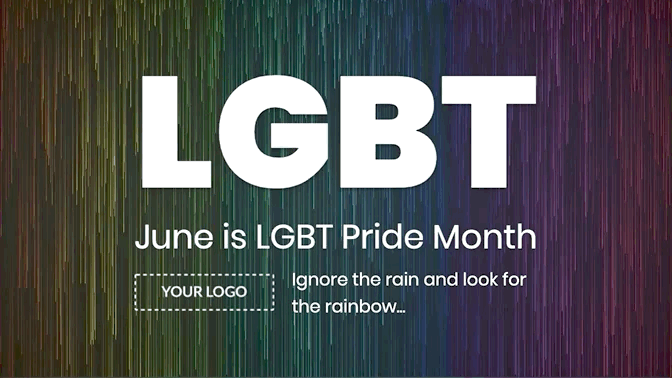
Get started with this digital signage template here.
Such recognition can be subtle, such as including diverse individuals in school signage and literature. Or it can be very clear, such as open school support for occasions like Black History Month, Hispanic Heritage Month, or Pride. Digital signage is an ideal tool to convey such support.
Values
Earlier in this post we discussed priming in the context of classroom achievement. However, a specific type of values-centric priming can have significant effects on student well-being and overall performance, not just on the task at hand.
Values-based priming involves having students affirm their own values, expressing the importance to them of their aspirations, family, goals, friends, faith or whatever their personal values may be. Crucially, this is effective when students choose their own values to affirm, not when they’re asked to agree with values suggested to them by others.
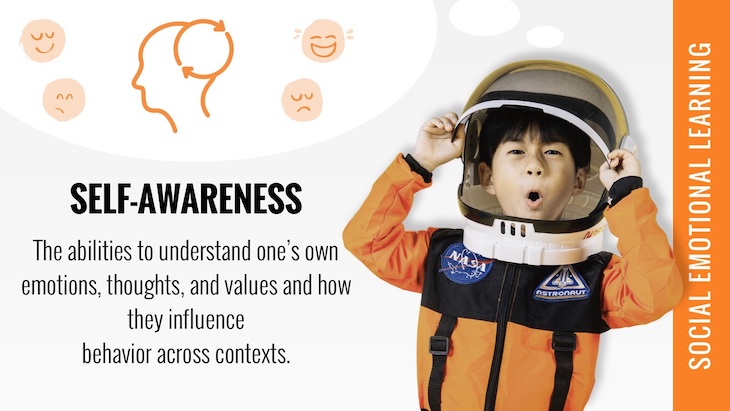
Get 8 Social and Emotional Learning posters for free from Rise Vision
Tying in with an increasing emphasis on SEL in schools, this type of values-based priming can have measurably positive effects on emotional stress as well as on academic achievement.
In one study, participants who affirmed their own values had ‘significantly lower cortisol responses to stress’ compared with the control group: values-based priming changed their brain chemistry.
In another study, college students who performed value-affirming writing exercises prior to a midterm exam had lower stress levels the day before the test. What’s key about this is that the effects are spread out: values-based affirmation improves the days around stressful events and makes everyday school life better and easier.
Digital signage can be effective in leading students to reconsider and reaffirm their own values in the context of school life, leading to a greater sense of self-efficacy and improved well-being.
Achievement
It’s important to celebrate student achievements as well as encouraging them. Digital signage in public areas of schools, such as hallways and cafeterias, is an ideal tool for this. From Cornwall-Lebanon School District, systems coordinator Scott Boyer says, ‘Our mascot is the Falcon… so one of our big student engagements that we use is the Wings of Praise, which is a way to recognize students that don't necessarily stand out in the crowd.’

Recognizing students for their sporting success or academic achievements is also a great use for digital signage, but those students will receive rewards already. Cornwall-Lebabon’s approach lets the school reward students whose achievements might defy easy categorization: ‘They might be good academically,’ as Scott explains, ‘they might be good athletically, but they just do good things generally. And those kids that get overlooked at times, we try to push them out to the forefront that they do get that recognition that they deserve, and Rise Vision has greatly helped us do that.’
Conclusion
Digital signage can have a profound effect on the life of a school and the experiences of its students. That starts with the ability to attract attention and help students engage with the signs themselves. But signage can be used to guide students’ attention, to encourage desirable behaviors, and to facilitate academic and personal growth.





